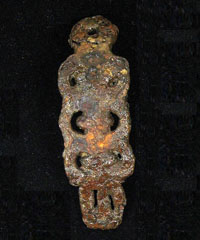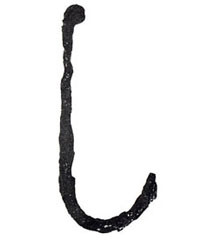
Spur part
|
|
This collection—predominantly metal—represents both French and Spanish construction efforts as well as the tools, equipment, and supplies for the various occupants at the site. Along with thousands of nail fragments, spikes, rusted metal bits, and pieces of baked clay daub, archeologists also recovered tools such as knives, tack for Spanish horses, kettle fragments, and several lead seals used on bales of hides and cloth. In contrast to the European goods, the more simple, chipped-stone tools of the Karankawa represent age-old traditional labors carried out in a rapidly changing world. Not shown are examples of the more than 250,000 animal bones recovered at the site, representing the farming and hunting successes of the various peoples at the site. The great majority (76%) were the bones of hooved animals (artiodactyls)—deer, bison, sheep, cow, goat, and domestic pig. The bones of turtle, fish, and bird bone also were present, rounding out our impression of what was on the menu at the site of Fort St. Louis and Presidio La Bahía. Enlarge each image to learn more.
|

Fishhook
|
|